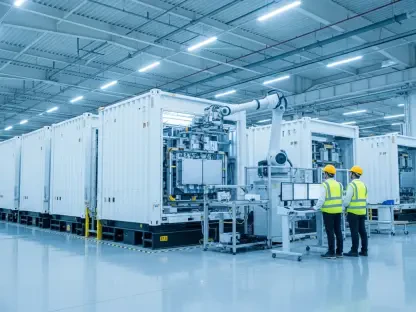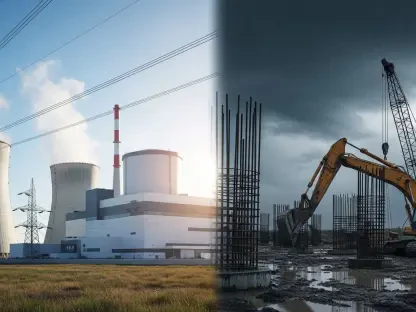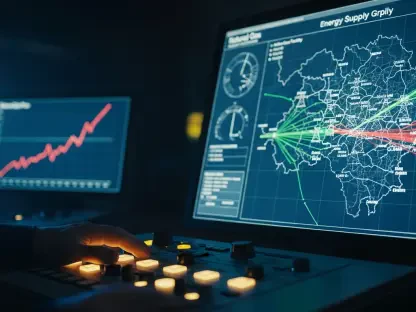The rapid advancements in artificial intelligence (AI) have sparked a global race to develop more powerful and efficient models. However, this progress comes with significant environmental and energy costs. The recent announcement of the Stargate project and the release of China’s DeepSeek R1 model have brought these issues to the forefront, prompting a critical examination of the sustainability of current AI development practices. As technology continues to evolve at an unprecedented pace, the question arises: Is the push for more advanced AI truly worth the substantial environmental and energy costs?
The Stargate Project: A Massive Investment in AI Infrastructure
The Stargate project, an ambitious endeavor backed by noted entities like OpenAI, Oracle, SoftBank, and MGX, seeks to pour up to $500 billion into constructing extensive data centers across the United States. This colossal investment rivals the expenses of historically significant ventures such as the Apollo space program and the US highway system. The project’s overarching goal is to bolster AI capabilities by securing extensive energy and computing power, thus setting the stage for revolutionary advancements in the field of artificial intelligence.
The groundwork for the Stargate initiative was laid in 2024, marked by a considerable surge in lobbying efforts from various AI companies. These efforts moved away from addressing conventional issues like deepfakes and misinformation, focusing instead on the acquisition of more substantial energy resources. Esteemed tech leaders, including OpenAI’s Sam Altman, have lauded the project, crediting its feasibility to the new Trump administration. Despite the commendations from industry insiders, the project has not been without its critics.
Environmental Concerns and Criticisms
The Stargate project has faced substantial backlash from environmental groups and critics who are deeply concerned about its potential impact on local grids and escalating energy costs. The reliance on carbon-intensive energy sources, such as coal, poses a significant point of contention. Environmental proponents argue that the project directly contradicts global efforts to reduce carbon emissions and combat the escalating threat of climate change. This environmental cost raises crucial questions about the overall public benefit of the Stargate project.
Critics argue that the environmental impact of the Stargate project outweighs any potential benefits it might bring to AI development. There’s a strong emphasis on the need for more sustainable approaches that do not compromise the environment. The massive scale of the project and its voracious resource consumption have prompted serious questions about its long-term viability and true public benefit. Notably, Elon Musk, a prominent figure in the tech world, has publicly questioned the financial capability of OpenAI and SoftBank to successfully execute the plan, further adding to the discourse surrounding the project’s merit.
The Emergence of DeepSeek R1: A New Approach to AI Efficiency
In stark contrast to the resource-intensive approach taken by the Stargate project, a Chinese startup has unveiled an AI reasoning model called DeepSeek R1. This model has demonstrated impressive efficiency and effectiveness comparable to those of OpenAI’s models, but without the need for unprecedented levels of computing power and energy consumption. The release of DeepSeek R1, coinciding with Trump’s inauguration, appears strategically timed to provoke concern among leaders in Silicon Valley.
Reasoning models like DeepSeek excel at tasks requiring math, logic, and decision-making. The success of DeepSeek challenges the prevailing notion that substantial data centers and advanced chips are indispensable for progress in AI. DeepSeek’s approach suggests that innovative and efficient design can produce powerful AI models without imposing a heavy environmental toll. This revelation potentially diminishes the urgency and necessity of projects like Stargate, emphasizing that AI advancements can be achieved through more sustainable means.
The Competitive Landscape: US vs. China in the AI Race
The United States has made it a priority to outcompete China in the AI race, evidenced by measures like the CHIPS Act and export controls on high-end chips targeted at China. However, the efficiency and competitiveness of DeepSeek indicate that China’s AI efforts remain formidable despite such constraints. This development poses a tangible threat to the existing business models of US AI companies, potentially leading to significant market shifts if freely accessible models like DeepSeek outperform expensive proprietary models.
In response to DeepSeek’s release, major tech companies, including Meta, are closely examining its design and efficiency. Meta’s considerable increase in capital investments for AI infrastructure underscores the competitive pressure posed by DeepSeek. This scenario highlights the contrasting approaches of US and Chinese AI models and the possibility of achieving AI efficiency without massive resource expenditure. These developments suggest that the competitive landscape of AI is set for significant transformations, driven by a reevaluation of resource-intensive strategies.
Rethinking AI Development: Balancing Progress and Sustainability
The rapid advancements in artificial intelligence (AI) have ignited a global race to create more powerful and efficient models. However, these advancements come with significant environmental and energy costs. The recent announcement of the Stargate project and the release of China’s DeepSeek R1 model have highlighted these issues, prompting a thorough examination of the sustainability of current AI development practices. As technology evolves at a remarkable speed, a crucial question arises: Is the pursuit of more advanced AI truly worth the substantial environmental and energy costs?
Balancing the benefits of AI with its environmental impact is a challenging yet essential task. The energy consumption required for training sophisticated AI models is immense, leading to increased scrutiny from both the scientific community and the general public. Evaluating the trade-offs between innovation and sustainability is imperative as society grapples with the realities of climate change and resource depletion. Moving forward, it becomes essential to explore and implement more eco-friendly AI development practices to ensure that progress doesn’t come at the planet’s expense.









